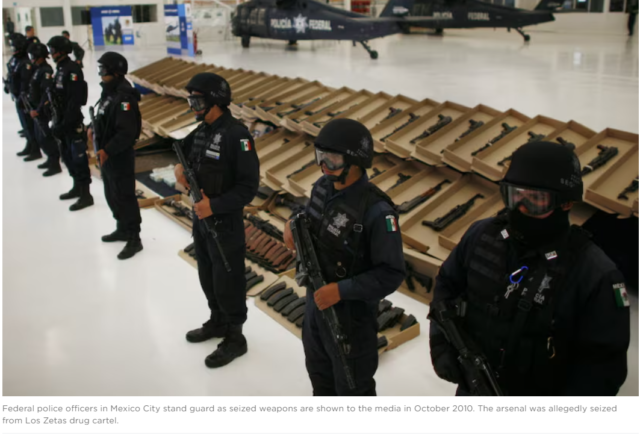
By Kevin Krause
Reprinted – by Texas Metro News
Guns purchased from a single ZIP code in Grand Prairie, Texas, have been popping up in Mexico in significant numbers over the past several years.
From 2015-2022, the 75051 ZIP code was the source of more confiscated guns – roughly three dozen per year – in Mexico than from any other Texas ZIP code not located on the border.
Furthermore, a recent federal firearms report shows Texas is the nation’s leading supplier of illicit guns to Mexico’s drug cartels and other criminal organizations, representing 43% of the total.
Those are among the revelatory findings culled from a federal gun tracing database obtained by a nonprofit organization and analyzed recently by The Dallas Morning News.
At first glance, the data might suggest Grand Prairie is a hub for international arms trafficking. Dig a little deeper, however, and a more nuanced story emerges – one that not only reveals the challenges of firearms tracing as a tool against gun traffickers, but also illuminates the ongoing national debate between gun rights groups and gun safety advocates over whether such data should be made public.
Tracing can be helpful to agents, revealing patterns used by criminals and identifying possible suspects. And it can be used to alert gun sellers. But the data also can be of limited value when a gun’s serial number is filed off, when the sales paperwork is missing or when the firearms are old.
Those guns from Grand Prairie are a prime example.
The 275 Grand Prairie confiscated guns, it turns out, are very old. Some were bought so long ago that the North Texas gun store owners who sold them are long dead.
Case in point: Some guns from that ZIP code trace back to Bobby Ray Langford, according to a second set of tracing data from Mexico shared with researchers. Langford was a licensed gun dealer at Traders Village before he went out of business in 1990 after being charged in a gun running scheme. Agents said he sold 500 guns that later ended up in Mexico. Langford died in 2008, several years after police said Traders Village, a popular Grand Prairie flea market, stopped gun sales.
Still, those Grand Prairie guns likely circulated for years on the second-hand market before they were confiscated in Mexico and run through a tracing database maintained by the Bureau of Alcohol, Tobacco, Firearms and Explosives.
“Historically (up until 2002), there were a large number of gun vendors legally selling firearms at Traders Village,” Grand Prairie police spokesman Mark Beseda said in an emailed statement. “While we cannot conclusively trace the origin of the guns recovered in Mexico, I suspect that was the source.”
The ATF gun-tracing database lists only where the guns were originally sold by ZIP code (and, thus, also by city and state). But it does not list who sold the guns, leaving Grand Prairie police to guess.
But the separate tracing data from Mexican government computers, leaked by hackers, gives that theory credence. That data, which The News also analyzed, not only traces guns to Langford, but also notes that six other Grand Prairie guns recovered in Mexico in 2018 and 2019 were bought at Guns N Such, another licensed dealer that went out of business, in 1996. Guns N Such also operated at the Traders Village flea market.
It’s easy to see from the Grand Prairie gun revelations — which largely came to light from the separate data leaked by Mexican hackers — why ATF has been caught in the middle of a fierce ongoing debate about whether or not to release more gun tracing information. Gun safety advocates have criticized the agency for not providing more information and transparency. At the same time, many in the gun industry want the agency to restrict such data to law enforcement.
That debate largely pits public safety against privacy concerns, especially from licensed gun sellers, including large retailers such as Katy-based Academy Sports + Outdoors, that show up on ATF lists as having sold multiple guns used in crimes. This makes them a potential target of gun safety groups, despite not having been accused of doing anything illegal.
The disagreements on how ATF should manage its gun data is heating up as mass shootings continue to rise, along with pressure for the U.S. to stop the illicit flow of rifles and handguns to Mexico that arm the drug cartels.
Gun ownership laws in Mexico, which has a single gun store, are much stricter than in the U.S. and require a license and stringent background check.
Among Texas metro areas, Houston has consistently led the state in the number of crime guns recovered in Mexico, according to an analysis of ATF data. But the Dallas-Fort Worth metro area nearly caught up to it in 2019 and 2020, the data show.
North Texas guns not only help Mexican drug cartels maintain their drug trafficking empires, they are sometimes also used in attacks that injure and kill Americans. That happened in 2011 in Mexico when a North Texas gun was used in an attack that killed one U.S. agent, Jaime Zapata, and wounded a second.
The true extent of the carnage, though, is unknown. Most U.S. guns found in Mexico are never submitted for tracing, authorities say.
A 2009 Government Accountability Office report estimated that fewer than a quarter of guns recovered there were provided to ATF for tracing. And ATF reported last year that 73% of guns found in Mexico and other foreign countries cannot be traced to an initial buyer for various reasons. They include incomplete or invalid firearm information submitted by police; removed serial numbers and other markings; and missing or incomplete gun store sales records.
Another problem hindering gun tracing is the accuracy of the information submitted. ATF says Mexican authorities don’t always timely or accurately enter firearm makes, models and serial numbers into the tracing system.
Sara Abel, spokeswoman for the Dallas ATF office, said some of the Grand Prairie guns could have been sitting in an evidence vault in Mexico for years before being entered recently into the agency’s tracing database, known as eTrace.
ATF statistics indicate Mexico is submitting more guns for tracing every year. In 2022, almost 12,000 American guns recovered in Mexico were submitted to ATF for tracing – a 45% increase over 2017.
The eTrace system helps investigators quickly learn the origin and purchaser of crime guns, providing them with strong investigative leads. Tracing helps ATF identify “trafficking corridors, patterns, schemes, traffickers, accomplices, and straw purchasers,” according to a 2010 Justice Department report.
“It leads us to that first purchaser,” Abel said.
But Peter J. Forcelli, a retired ATF deputy assistant director, told The News that tracing is generally only useful in trafficking cases if the guns are recovered within two years of their initial retail purchase.
“Anything less than two years is something that would be suspicious,” said Forcelli, who worked as a Phoenix ATF supervisor.
Tracing allows ATF to determine the “time-to-crime,” or the time between the gun’s initial retail purchase and its recovery in a crime. The shorter this period is, the more likely the gun was bought for criminal purposes, officials say. The bureau considers a gun recovery within three years to be indicative of trafficking.
A 2010 Justice Department report said the Northern District of Texas that includes Dallas typically did not accept ATF gun trafficking cases if the recovery occurred more than a year after the retail sale.
| This story, originally published in The Dallas Morning News, is reprinted as part of a collaborative partnership between The Dallas Morning News and Texas Metro News. The partnership seeks to boost coverage of Dallas’ communities of color, particularly in southern Dallas. |









